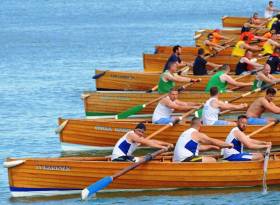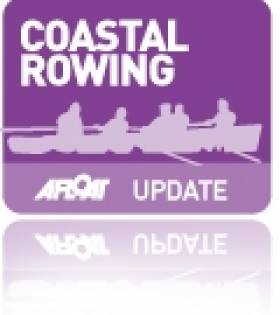Displaying items by tag: East Coast Rowing
2018 East Coast Rowing Fixtures Published
Following yesterday’s AGM of the East Coast Rowing Council, the fixture list for their 2018 regatta season has been released. (Downloadable below). Crews of men, women, and children from Skerries in the north to Arklow in the south will compete for the individual regatta medals and trophies, for the championship league positions, and for the overall club shields.
In a departure from tradition, which is that regattas are held on a Sunday unless there is a bank holiday, the fixture list includes a Saturday Regatta in June. It is relative newcomers Skerries Rowing Club, established in 2012, that have taken this bold move. Holding with tradition, the 140th Wicklow Regatta will be held on the August Bank Holiday Monday
Regattas are held on the ‘home’ courses of each club., on the bays, estuaries, and open water of the east coast of Ireland. All regattas feature races from Under 12s through to Senior Men and Senior Women, with 5-12 boats per race and up to 13 races spread over the afternoon.
Last year was a hugely busy and successful year on the East Coast, with the St. Michael’s Regatta in Dun Laoghaire falling just 2 crews short of the all-time record for entries, which was set at the 2017 Wicklow Regatta at 125 crews. In terms of results, the two Ringsend clubs managed to share the overall season’s spoils between them, with Stella Maris taking the Junior Shield, and St. Patrick’s taking both the Senior Shield and the Overall Shield.
Clubs can look forward to strong growth over the coming year, with new builds for 7 East Coast skiffs having been awarded grant aid in the 2017 round of Sports Capital Grants. With these boats being unique to Dublin and Wicklow, the growth of the fleet is a source of pride for all who row these fine boats.
East Coast Rowing Gets Extended 2017 Fixtures Calendar
This week sees the launch of the fixture list for the East Coast Coastal Rowing regatta circuit 2017. Crews of men, women, and children from Skerries in the north to Arklow in the south will compete for the individual regatta medals and trophies, for the championship league positions, and for the overall club shields. Fixtures can be found below.
To facilitate the recent growth in the sport, this year sees the season being extended earlier, into mid-May, and later, into mid-August. The 139th Wicklow Regatta will be held on the August Bank Holiday Monday, but in a break with tradition, there will be an official regatta after this fixture, hosted by Dalkey Rowing Club.
Regattas are held largely on Sundays on the 'home' courses of each club. All regattas feature races from Under 12s through to Senior Men and Senior Women, with 5-12 boats per race and up to 13 races spread over the afternoon.
This fixture list arises off the back of Sunday's East Coast Rowing Council AGM, where exciting prospects for the season ahead were discussed. Skerries Rowing Club’s regatta will be held in conjunction with the Skerries Water Festival and St. Michael’s Rowing Club of Dun Laoghaire will be collaborating with the Volvo (sailing) regatta and the Dun Laoghaire Harbour bicentennial. The newly formed Fingal Rowing Club was also admitted to the ECRC.
Last year was a hugely busy and successful year on the East Coast, with the Wicklow Regatta beating the all-time record for entries and 125 crews. The two Ringsend clubs managed to share the overall spoils between them, with St. Patricks taking the Senior Shield, and Stella Maris taking both the Junior Shield and the Overall Shield.
2017 events and regattas
Arklow Rowing Club, Arklow Sun 21 May
Skerries Rowing Club, Skerries Sun 18 June
Bray Rowing Club, Bray Sun 25 June
St. Michael’s Rowing Club, Dun Laoghaire Sun 9 July
Stella Maris Rowing Club, Ringsend Sun 16 July
St. Patrick’s Rowing Club, Ringsend Sun 30 July
Greystones Rowing Club, Greystones Sat 5 August
Wicklow Rowing Club, Wicklow Mon 7 August
Dalkey Rowing Club, Sandycove Sun 13 August
East Coast Rowers Line Up for 2015, Download Coastal Rowing Fixtures Here!
#coastalrowing – This week sees the launch of the fixture list for the East Coast Rowing regatta circuit. Crews of men, women, and children from Skerries in the north to Courtown in the south will compete for the individual regatta medals and trophies, for the championship league positions, and for the overall club shields. Download the East Coast Fixtures List for 2015 below as a jpeg file.
The season kicks off on 7th June at the Arklow Regatta, and continues for most Sundays at the 'home' courses of each club. The season finishes with the traditional August Bank Holiday 'Double Header' at Greystones on Saturday 1st, followed by the 138th annual Wicklow Regatta on Monday 3rd. All regattas feature races from Under 12s through to Senior Men and Senior Women, with 5-12 boats per race and around 13 races spread over the afternoon.
This fixture list arises off the back of Sunday's East Coast Rowing Council AGM, where exciting prospects for the season ahead were discussed. It is hoped to see a tentative return to regatta racing for the newly reborn East Wall Rowing Club, with other new entrants in the offing too. Arklow and Bray Rowing Clubs will celebrate their 25th and 80th anniversaries respectively, and there will be interesting changes to the race courses at both Arklow and the St. Michael's course at Dún Laoghaire. Congratulations were extended to Dalkey Rowing Club who have a new rowing skiff under construction.
Last year was a hugely busy and successful year on the East Coast, with some regattas pushing 100 crews. The two Ringsend clubs managed to share the overall spoils between them, with St. Patricks taking the Senior Shield, and Stella Maris taking both the Junior Shield and the Overall Shield.

























